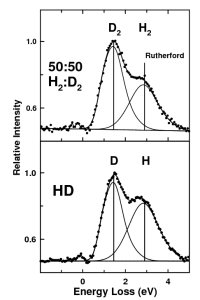
Contact Info
Adam P. Hitchcock
Canada Research Chair
in Materials Research
CLS-CCRS
B.I.M.R
McMaster University
Hamilton, ON
Canada L8S 4M1
V: +1 905 525-9140
x24729
F: +1 905 521-2773
E: aph@mcmaster.ca
U: unicorn.mcmaster.ca
__________
Research
Group
Opportunities
Publications
Links
_____________

Anomalous quasi-elastic scattering of hydrogen isotopes
 WHO:
Glyn Cooper, Adam
Hitchcock, BIMR, McMaster University;
WHO:
Glyn Cooper, Adam
Hitchcock, BIMR, McMaster University;
Aris
Chatzidimitriou-Dreismann, Chemistry, Technical University, Berlin
WHERE:
ABB-332 McVAHRES - McMaster Variable Angle High Resolution
Electron Scattering
WHEN: 2007 POSTED:
19 Feb 2008
WHAT: At large scattering angles (>60 deg) and moderate or high impact energies (>2 keV) the atoms of a gas phase molecule (or a solid) scatter the electron beam independently from their neighbours, resulting in quasi-elastic electron scattering which can give rise to peaks separated by several eV in energy. The positions of these peaks are accurately predicted by simple conservation of energy and momentum considerations (Rutherford formula). The intensity should be proportional to the square of the atomic number and number of that type of atom in the molecule. Thus the signal for HD and a 50:50 mixture of H2:D2 should be the same. However, our measurements show a 30% deficiency of intensity of H2 relative to HD or D2 (see figure). The origin of this anomaly is not yet determined, but may be related to quantum entanglement of the incident electron and target nucleus on the attosecond time scale of the scattering. Further studies are underway to see if this relatively simply macroscopic scattering measurement can provide insight into quantum entanglement and the process of decoherence
REFERENCE: G. Cooper, A. P. Hitchcock and C. A. Chatzidimitriou-Dreismann, Anomalous quasi-elastic electron scattering from single H2, D2 and HD molecules at large momentum transfer: Indications of Nuclear Spin Effects, Phys.l Rev. Letts 100 (2008) 043204-(1-4).
© 2008 A.P. Hitchcock / McMaster University
- All Rights Reserved
web site design by Christopher Amis (2002). Last updated on 18 Feb 2008
(aph)

